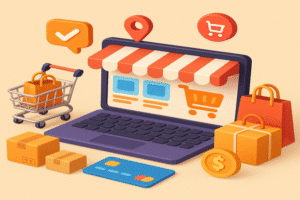e-commerce
What is E-commerce ?
E-commerce refers to the process of buying and selling goods and services over the internet, enabling individuals and businesses to conduct commercial transactions without the need for physical presence in stores or actual locations. E-commerce allows users to access a wide range of products and services easily and quickly, which contributes to enhancing the efficiency of the global market and facilitates marketing and sales operations.
E-commerce is divided into several types, including Business-to-Business (B2B) commerce, which involves transactions between companies. For example, manufacturers can sell their products to retailers. On the other hand, Business-to-Consumer (B2C) commerce represents transactions that occur between companies and individual consumers, such as purchases from major online stores. Consumer-to-Consumer (C2C) commerce occurs when individuals sell goods or services to each other through electronic platforms such as specialized websites or apps.
The importance of e-commerce continues to grow amid the rapid development of technology and the digital world. This type of commerce contributes to changing consumer behavior, as offers and financial transactions have become easier and more considerate of time and effort. It also helps create new job opportunities and boost the growth of local and global economies. Thanks to e-commerce, companies can now reach new markets without geographical limitations, which facilitates trade exchange and continuously develops businesses.

Benefits of E-commerce
E-commerce is one of the most prominent growth areas in today’s digital economy, offering global market access, allowing businesses to surpass traditional geographic boundaries. This access enhances expansion opportunities and significantly increases the customer base, which in turn leads to higher revenues. While locally limited companies previously struggled to attract foreign customers, e-commerce now enables them to present their products and services to international markets through a single platform.
Moreover, e-commerce significantly helps reduce operational costs. By minimizing or even eliminating the need for physical stores, companies can invest resources more effectively. For example, businesses that rely on e-commerce reduce expenses related to rent and storage, allowing them to offer competitive prices to the public. This also benefits consumers, who find affordable prices and a wide range of options.
Increased flexibility in working hours is another key benefit of e-commerce. It allows businesses to operate around the clock, providing a convenient shopping experience for consumers and increasing product sales opportunities. Thanks to this flexibility, companies can quickly respond to market trends and changing customer demands, facilitating innovation and the introduction of new offers.
Finally, e-commerce enhances the customer experience by improving their interactions with brands. With diverse payment options and user-friendly platforms, customers can enjoy a seamless shopping journey. The availability of reviews and comparisons helps buyers make informed decisions, which increases their satisfaction and repeat purchase rates.
Challenges Facing E-commerce
E-commerce is a modern and innovative method for delivering products and services to consumers. However, it faces several challenges that may affect its growth and sustainability. One of the most significant of these challenges is security and privacy concerns. Many users worry about the safety of their personal and financial information when shopping online. Therefore, companies must implement strong security protocols such as data encryption and monitoring systems to ensure transaction safety.
In addition, the high level of competition in the digital marketplace is another issue facing e-commerce. Many companies are moving into the online space, making it harder to differentiate products and services. As a result, businesses face ongoing challenges in maintaining a competitive edge. Innovative digital marketing solutions, such as search engine optimization and social media marketing, have become essential for attracting customers and building a strong brand.
Trust with customers is also an important challenge, as companies need to build reliable relationships with their clients. This requires transparency in policies and rules, along with excellent customer service. Consumers need to feel safe and comfortable when making purchases. This can be achieved by providing accurate information, responding quickly to inquiries, and offering guarantees to meet customer needs.
In conclusion, it is essential for companies to recognize these challenges and develop effective strategies to overcome them. This will help improve the consumer experience and support the sustainable growth of e-commerce.

The Future of E-commerce
E-commerce is heading toward a promising future filled with innovations and developments that will reshape the commercial landscape as we know it today. One of the key expected trends is the increasing reliance on artificial intelligence, which contributes to improving the shopping experience by offering personalized recommendations and analyzing consumer behavior more effectively. Thanks to machine learning capabilities, smart applications can analyze vast amounts of data and provide innovative solutions that enhance the ability of online stores to target ideal customers.
Moreover, augmented reality technologies are expected to enhance consumers’ ability to experience products in new and innovative ways. Shopping experiences involving augmented reality allow customers to see how products will look in their daily lives before purchasing, reducing return rates and helping them make more informed decisions. For instance, online clothing stores can use this technology to allow customers to virtually try on outfits, which contributes to increasing satisfaction and boosting sales.
Additionally, global reports indicate that digital payment will continue to evolve, with smartphone wallets and blockchain emerging as primary payment methods. These methods make it easier and safer for customers to complete transactions, promoting a stronger culture of online shopping. Companies can prepare for these changes by updating their digital infrastructure and providing ongoing training to their teams to ensure they fully benefit from these trends.



No comment